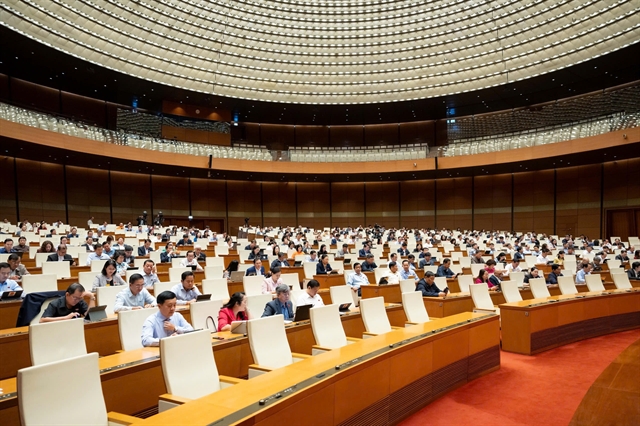 Politics & Law
Politics & Law


|
| The National Assembly's meeting on November 14 in Hà Nội. VNA/VNS Photo |
HÀ NỘI — The National Assembly (NA) deputies on Monday opened an intense debate over the sweeping investment and compensation policies required for the proposed Gia Bình International Airport, a next-generation aviation hub that would reshape the northern region’s transport landscape but also trigger one of the largest land clearance efforts in recent memory.
Presenting the Government’s submission and the verification report, Construction Minister Trần Hồng Minh said Nội Bài International Airport in Hà Nội remains the principal international gateway for the capital city and the northern key economic region.
From 2014 to 2024, passenger volume at Nội Bài airport grew by around 11.8 per cent each year, exceeding the national average growth rate and now operating above its designed capacity.
Meanwhile, compared with major airports in the region, Nội Bài lags behind in service quality and technological standards.
Although the ministry was studying plans to expand Nội Bài southward, the proposal faces significant challenges, including the need to relocate large communities and extremely high land clearance costs, requiring extensive time to implement.
According to the minister, the Gia Bình Airport project aligns with the national master plan for 2025-2030 with a vision to 2050, the master plan on the development of Việt Nam’s international airport network for the same period, the Gia Bình Airport master plan and Bắc Ninh Province’s planning framework.
He stressed that Gia Bình International Airport would be developed to international standards, becoming a smart, green and sustainable next-generation hub.
It aims to achieve five-star international service quality, rank among the world’s top ten five-star airports assessed by Skytrax and offer world-class passenger experience recognised by Airports Council International.
The airport is expected to serve as a key northern gateway, a regional passenger and cargo transit hub and a centre for aircraft maintenance, repair and overhaul in the Asia–Pacific region.
It will also serve dual-use functions and support major diplomatic events, including the upcoming APEC 2027 that Việt Nam will host.
Total land demand is estimated at more than 1,800ha, including 920ha of two-crop rice fields requiring conversion.
The project will affect around 7,100 and 18 organisations; approximately five thousand eight hundred households will require resettlement and around 18,800 graves will need to be relocated.
Several irrigation structures, canals, pumping stations, power transmission lines and social infrastructure such as schools and religious facilities must also be relocated or rebuilt.
Special mechanisms for relocating heritage sites
Within the project’s land clearance boundary, around 25 historical and cultural sites must be relocated.
Current heritage laws only permit relocating artefacts, not entire structures. To address this, the Government asked the NA to grant Bắc Ninh Province permission to relocate heritage structures under a special mechanism. Relocations would follow provincial plans ensuring maximum preservation and value protection; the Government would provide guidance for any issues arising during implementation.
The Government requested the NA to approve the project and the special investment mechanisms.
Presenting the verification report, chairman of the Committee for Economic and Financial Affairs Phan Văn Mãi said the committee agreed on the necessity of the project and confirmed that its documentation meets legal requirements for NA consideration.
The committee largely concurred with the project’s objectives, scale, location, timeline, land demand, land clearance plan, resettlement, technology options and environmental solutions.
However, it requested clearer quantification of project goals, detailed geological and hydrological assessments, evaluation of impacts on the Ngụ River and clarification of the multimodal transport connectivity plan aligned with the project’s completion schedule.
The committee also urged a thorough feasibility review to determine whether phase one can be completed in time to support APEC 2027, given current land clearance challenges.
It also called for clear mechanisms for vocational training and job creation for affected residents.
Regarding the seventy-year operational term, the committee recommended basing the timeframe on actual capital recovery periods and conducting five-year reviews to update revenue, expenditure and profit projections, ensuring balanced benefits for the State, investors and users.
On investment costs, the committee asked for clearer calculation methods, comparison with similar regional airports and adjustments reflecting local price levels.
For the special mechanism on relocating heritage sites, the committee agreed in principle but asked for detailed provisions on post-relocation procedures, including re-certification of heritage sites and safeguards to maintain original cultural and historical values.
It emphasised the need for a detailed conservation plan, impact assessment and supervision mechanism with clear roles assigned to the Ministry of Culture, Sports and Tourism.
The committee urged transparent responsibilities, deadlines and reporting duties for Bắc Ninh authorities, enhanced oversight by the NA and central agencies and the application of advanced scientific and technological methods to prevent distortion of heritage sites.
It also recommended that the Government report to the NA at its 10th session on the implementation of Government Resolution No 03 which sets out special mechanisms for the Gia Bình airport project. — VNS